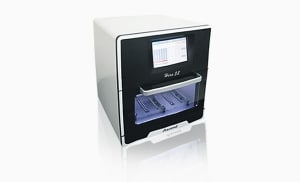Features of Nucleic Acid Extraction System and Precautions for Use
The nucleic acid extraction system is a biomedical system designed for automatic magnetic bead method nucleic acid extraction. You only need to add the sample to be extracted to the matching kit, put the kit into the extraction system, run the edited program that comes with the system, and complete a round of sample nucleic acid extraction in 15 to 30 minutes. The use of magnetic bead method nucleic acid extraction system is generally divided into two types: suction method and magnetic rod method.
ONE. The characteristics of the magnetic bead method of nucleic acid extraction system
1.Able to realize automation and high-throughput operation.
2. The operation is simple and fast.
3. Safety and environmental protection.
4. High purity and high yield.
5. No pollution and stable results.
6. Low cost, convenient for wide application.

TWO. Use method of magnetic bead method nucleic acid extraction system
1. Suction method
Also called pipetting method, nucleic acid extraction is achieved by immobilizing magnetic beads and transferring liquid. Generally, the transfer is achieved by controlling the mechanical arm through the operating system. The extraction process is as follows:
① Lysis: Add the lysis solution to the sample, realize the mixing and full reaction of the reaction solution through mechanical movement and heating, cell lysis, and release of nucleic acid.
②Adsorption: Add magnetic beads to the sample lysis solution and mix them thoroughly. The magnetic beads have a strong affinity for nucleic acids under high salt and low pH values to adsorb nucleic acids. Under the action of an external magnetic field, the magnetic beads are separated from the solution. Use the tip to remove the liquid and discard it to the waste tank, and discard the tip.
③Washing: Remove the external magnetic field, replace with a new tip, add washing buffer solution, mix thoroughly to remove impurities, and remove the liquid under the action of the external magnetic field.
④Elution: Remove the external magnetic field, replace with a new tip, add elution buffer, mix thoroughly, and the bound nucleic acid is separated from the magnetic beads to obtain purified nucleic acid.
2. Magnetic rod method
The magnetic rod method realizes the separation of nucleic acids by fixing the liquid and transferring the magnetic beads. The principle and process are the same as the suction method, but the difference is the method of separating the magnetic beads and the liquid. The magnetic rod method is to separate the magnetic beads from the waste liquid through the adsorption of the magnetic beads on the magnetic rod, and put them into the next liquid to realize the extraction of nucleic acid.
THREE. Precautions for the use of magnetic bead method nucleic acid extraction system
1. The installation environment of the system: normal atmospheric pressure (altitude should be lower than 3000m), temperature 20-35℃, typical use temperature 25℃, relative humidity 10%-80%, unobstructed air flow is 35℃ or below.
2. Avoid placing the system close to a heat source, such as an electric heater; at the same time, to prevent short circuits of electronic components, avoid splashing water or other liquids into it.
3. The air inlet and exhaust vent are located on the back of the system, while avoiding dust or fibers from gathering at the air inlet and keeping the air duct unobstructed.
4. The nucleic acid extraction system is at least 10cm away from other vertical surfaces,
5. Grounding of the system device: In order to avoid electric shock accidents, the input power cord of the system device must be grounded.
6. Keep away from live circuits: Operators are not allowed to disassemble the system without authorization. Replacement of components or internal adjustments must be completed by qualified professional maintenance personnel. Do not replace components when the power is turned on.
At present, the magnetic bead method nucleic acid extraction system is widely used in various fields such as environmental microbial testing, food safety testing, blood transfusion safety, forensic medicine identification, disease control centers, clinical disease diagnosis, biological research, and animal husbandry.



